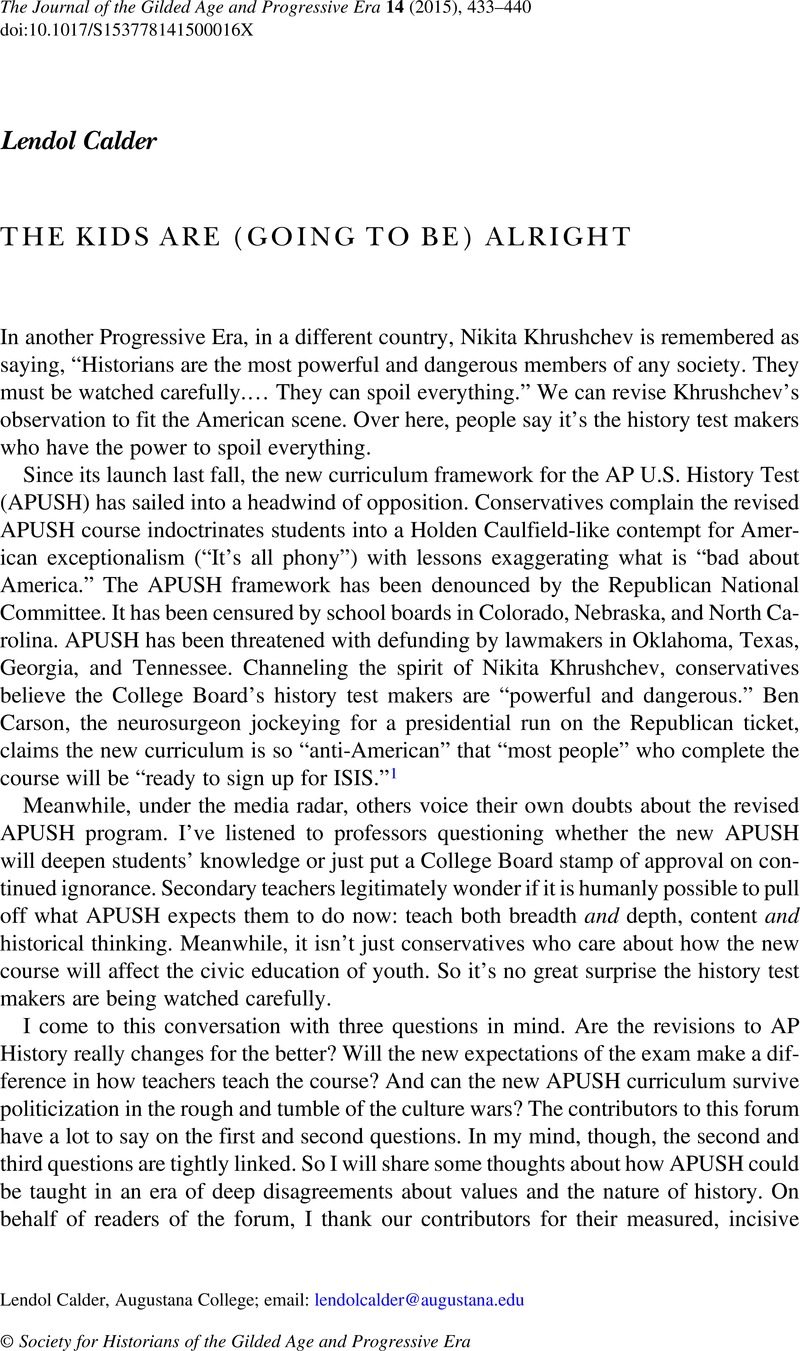No CrossRef data available.
Article contents
THE KIDS ARE (GOING TO BE) ALRIGHT
Published online by Cambridge University Press: 22 July 2015
Abstract

- Type
- Teaching Forum: Pedagogy and Controversy in The New Advanced Placement U.S. History Framework
- Information
- Copyright
- Copyright © Society for Historians of the Gilded Age and Progressive Era 2015
References
NOTES
1 Valerie Strauss, “Ben Carson: New AP U.S. History Course Will Make Kids Want to ‘Sign Up for ISIS’,” Washington Post, September 29, 2014, http://www.washingtonpost.com/blogs/answer-sheet/wp/2014/09/29/ben-carson-new-ap-u-s-history-course-will-make-kids-want-to-sign-up-for-isis/.
2 For more on the coverage model and its inadequacies, see Calder, Lendol, “Uncoverage: Toward a Signature Pedagogy for the History Survey,” Journal of American History 92 (March 2006): 1358–69CrossRefGoogle Scholar; Sipress, Joel and Voelker, David, “The End of the History Survey Course: The Rise and Fall of the Coverage Model,” Journal of American History 97 (March 2011): 1050–66CrossRefGoogle Scholar; and chapter 2, “On the Limits of Collective Memorialization and Persistent Instruction” in Bruce A. VanSledright, The Challenge of Rethinking History Education: On Practices, Theories, and Policies (New York: Routledge, 2010).
3 Bruce Lesh, “Why Won't You Just Tell Us the Answer?”: Teaching Historical Thinking in Grades 7–12 (Portland, ME: Stenhouse Publishers, 2011); Sam Wineburg, Daisy Martin, and Chauncey Monte-Sano, Reading Like a Historian: Teaching Literacy in Middle and High School History Classrooms (New York: New York Teachers College Press, 2011); Stephane Levesque, Thinking Historically: Educating Students for the 21st Century (Toronto: University of Toronto Press, 2009); Chauncey Monte-Sano, Susan De La Paz, and Mark Felton, Reading, Thinking, and Writing About History: Teaching Argument Writing to Diverse Learners in the Common Core Classroom, Grades 6–12 (New York: Teachers College Press, 2014); S. G. Grant and Jill Gradwell, eds., Teaching History with Big Ideas: Cases of Ambitious Teachers (Lanham, ME: Rowman and Littlefield, 2010); Bruce VanSledright, The Challenge of Rethinking History Education: On Practices, Theories, and Policy (New York: Routledge, 2011); Nikki Mandell and Bobbie Malone, Thinking Like a Historian: Rethinking History Instruction (Madison: Wisconsin Historical Society Press, 2008); Stanford History Education Group: Charting the Future of Teaching the Past website, https://sheg.stanford.edu/.”
4 Cuban, Larry, “Persistent Instruction: The High School Classroom, 1900–1980,” Phi Delta Kappan 64 (Oct. 1982): 113–18Google Scholar.
5 Diane Ravitch and Jon Wiener, “American History 101,” Slate, May 17, 2005, http://www.slate.com/articles/arts_and_life/history_book_blitz/features/2005/american_history_101/how_to_revive_history_by_teaching_the_conflicts.html. The authors of the 1994 National History Standards recount the controversy in Gary Nash, Charlotte Crabtree, and Ross Dunn, History on Trial: Culture Wars and the Teaching of the Past (Vintage, 2000); an excellent essay from one of the major players is Diane Ravitch, “The Controversy over National History Standards” in Elizabeth Fox-Genovese and Elisabeth Lasch-Quinn, eds., Reconstructing History: The Emergence of a New Historical Society (New York: Routledge, 1999), 242–52.
6 In an Op-Ed defending the Common Core, Bennett writes: “We can all agree that there are common and shared truths in English, literature and math.” Tellingly, Bennett, the author of a three-volume history of the United States did not include history on that list. See “The Conservative Case for Common Core,” Wall Street Journal, September 10, 2014, http://www.wsj.com/articles/william-j-bennett-the-conservative-case-for-common-core-1410390435.
7 Gerald Graff, Beyond the Culture Wars: How Teaching the Conflicts Can Revitalize American Education (New York: Norton, 1993).
8 I say more about the need for metanarratives in history survey courses in Calder, Lendol, “The Stories We Tell,” OAH Magazine of History 27:3 (2013)CrossRefGoogle Scholar, http://maghis.oxfordjournals.org/content/27/3/5.extract.
9 For a description of what such a course might look like, see Lendol Calder, “But What is Our Story?” at Teachinghistory.org, http://teachinghistory.org/issues-and-research/roundtable-response/24660.




